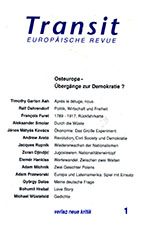Zwei Gesichter Polens, zwei Gesichter Europas
Two Faces of Poland, Two Faces of Europe
Author(s): Adam MichnikSubject(s): Civil Society, Government/Political systems, Transformation Period (1990 - 2010), Post-Communist Transformation
Published by: Institut für die Wissenschaften vom Menschen
Keywords: Polish Round Table; post-communist Transformation in Poland; Solidarnosc;
Summary/Abstract: Using the example of the Soviet Union, one can clearly show that there are two anti-communisms that fight each other: a liberal, pluralistic and European one, as represented by Sakharov, and a xenophobic, authoritarian and backward-looking, restorative one, such as that of Igor Schafarewitsch1 is championed. Last but not least, this second type of anti-communism is characterized by the paradox that he does not want to give up the figure of Stalin because he was the creator of the Great Russian Empire. The dictatorship should not be abolished but continued in another form ~; collective ownership continues, only that the collective farms are replaced by the more traditional artel. This movement does not see its main enemy in the communists, but in those people who want to build democratic institutions and an open society. What this anti-communism has in common with the old Stalinists is the fight against Europe, greed for money, godlessness and the decline of morals: Russia must be protected from this by building an anti-European bloc within Russian culture. How about Poland?
Journal: Transit
- Issue Year: 1990
- Issue No: 01
- Page Range: 185-189
- Page Count: 5
- Language: German

